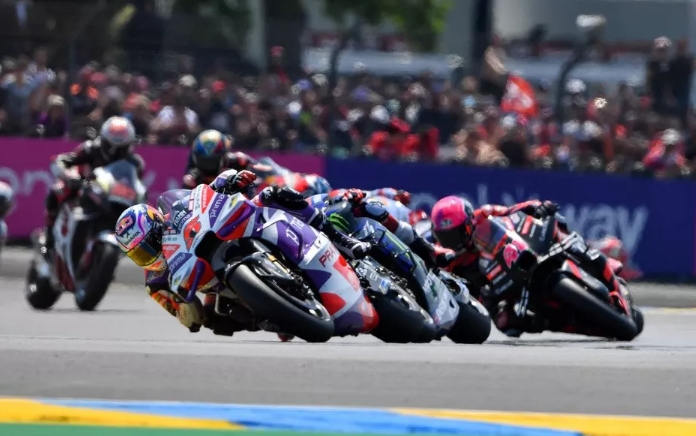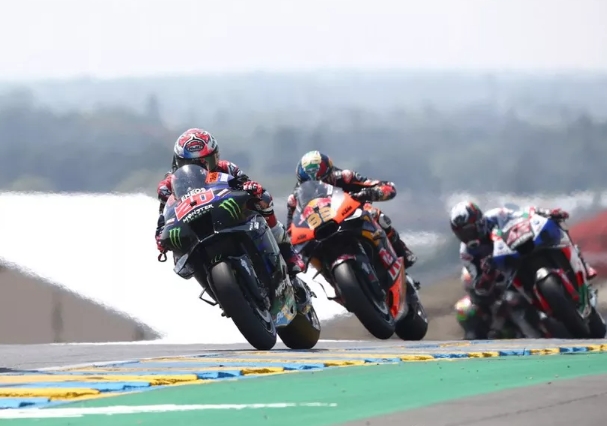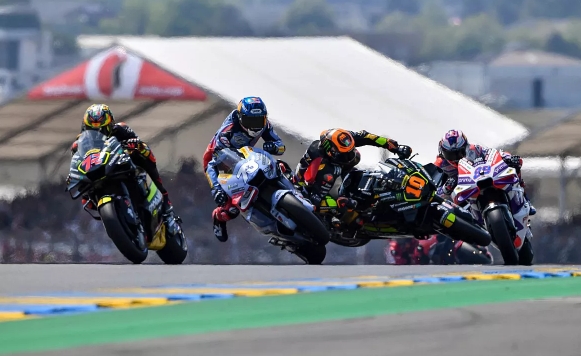The dynamic of MotoGP races has undergone a significant transformation in recent years, leading to a surge in chaos on the track. The majority of the grid now possesses highly capable machinery that enables them to contend for podium finishes. Consequently, this heightened competitiveness has resulted in an upswing in collisions occurring from race to race. The ongoing dilemma revolves around finding the appropriate equilibrium between thrilling and safe racing. The question remains: Is MotoGP effectively striking the right balance in this regard?
The tight competition within the MotoGP field, combined with the aerodynamic challenges posed by the current bikes, has contributed to a surge in aggression during race starts. The intense battle for position and limited overtaking opportunities have led to a higher frequency of accidents. Riders are pushing the limits to gain an advantage in the early stages, resulting in a more aggressive approach. The intricate relationship between the closely contested field and the aerodynamics of the bikes sheds light on the escalating number of incidents in MotoGP races.
Statistics, when correctly analyzed, have the ability to mirror reality. This principle holds true in the world of MotoGP, where the past four years have seen four different champions from four different manufacturers. Many riders, often known for their use of clichés, have been emphasizing the unprecedented level playing field in the series.
Valentino Rossi, Casey Stoner, Jorge Lorenzo, and Dani Pedrosa earned the nickname “Fantastic Four” due to their remarkable dominance over their competitors. However, when Stoner retired at the end of 2012, a new contender emerged to join the elite group: Marc Marquez. From 2013 to 2016, these four riders claimed a staggering 61 victories, establishing a seemingly unbreakable status quo. The emergence of Jack Miller, who became the first satellite rider to win a grand prix in a decade at Assen, marked a turning point, introducing a newfound instability into the championship.
This sentiment is not only expressed by the riders themselves, but it is also supported by the statistics. Looking at the 57 grands prix held since the start of 2020, which is a slightly shorter timeframe than the mentioned three and a half years, we witnessed a total of 16 different winners. The seasons of 2018 and 2020, in particular, stood out for their remarkable diversity, with each season seeing up to nine different winners.

The current level of unpredictability can be attributed to the modern technical and sporting regulations, which have led to a significant narrowing of the field in MotoGP, reaching levels that were previously unimaginable. Whether this development is positive or negative is entirely subjective, as opinions in the paddock vary, with some expressing favorability towards the change while others hold unfavorable views.
However, what cannot be denied is the undeniable impact of this “democratization” on the race dynamics and the heightened concern over the frequency of accidents occurring during the initial laps, both on Saturdays in the sprint races and on Sundays. This has become one of the prominent topics of discussion in MotoGP.
Following the introduction of the new weekend format, numerous riders have expressed their concerns regarding the heightened aggression observed at the start of MotoGP races. Sources consulted by Autosport have identified two key factors contributing to this phenomenon. Firstly, the increased competitiveness across the field, providing every rider with a realistic chance of reaching the podium or securing a victory. Secondly, the nature of the races, often forming a train or single-file procession due to the inherent challenges faced by current bikes when it comes to overtaking. This situation draws parallels to Formula 1 prior to the implementation of the DRS (Drag Reduction System) as a means to facilitate overtaking opportunities.
World champion Francesco Bagnaia eloquently highlights the profound impact that the newfound opportunity for certain riders to contend for victory has on their mindset, even in circumstances where success seemed nearly unattainable before. He explains:
“Many crashes occur at the start due to the heightened excitement and the subsequent tendency for riders to rush. In today’s landscape, all motorcycles possess the capability to win. The multitude of aerodynamic components introduced in recent times, such as fins, ride-height adjusters, and scoops, contribute to the formation of these groups of riders, known as trains, which consequently lead to increased heat and mounting pressure on the front tire. Once that threshold is breached, the outcome becomes inevitable.”
Fabio Di Giannantonio proposes an intriguing idea inspired by Formula 1’s use of DRS. He suggests:
“Imagine if we implemented a similar concept with the ride height device. It could be selectively activated under specific conditions. This approach would promote a sense of composure while simultaneously injecting an element of spectacle, as it would create temporary power imbalances.”

“For the past two years, we’ve been witnessing a trend of riders attempting to secure a win right from the first lap. Even if their potential for victory is limited, they aggressively maneuver to overtake multiple riders in a single lap, understanding it as their best opportunity to gain positions. However, this approach is flawed. Pushing beyond our limits is a mistake with significant consequences. It’s essential that we race with a strategic mindset, recognizing that exceeding our capabilities can lead to adverse outcomes.”
Despite their contrasting backgrounds and track records, Fabio Di Giannantonio shares the same perspective as his Ducati teammate, further affirming their shared thesis on the matter.
“The challenge of overtaking with these bikes has become incredibly tough. That’s precisely why we strive to make significant progress at the start, as securing a position at the front of the pack often sets the tone for the rest of the race,” concurs the Gresini rider, delving further into the matter.
“There’s a need to adopt a more aggressive approach and take calculated risks at the beginning because we no longer witness races where starting from eighth allows gradual advancement. Nowadays, if you find yourself in eighth place by the fifth lap, it’s quite expected that making substantial gains becomes exceedingly challenging,” he elaborates.
The responsibility for addressing and rectifying this situation, along with its limitations, lies with the Grand Prix Commission, the governing body empowered to enact necessary changes, provided a consensus is reached. The existing technical regulations are set to expire in 2026, and the Manufacturers’ Association (MSMA) has been engaged in extensive discussions regarding the forthcoming modifications to be implemented.
Among the key points under consideration are the potential removal of ride height devices and the introduction of limitations on aerodynamic elements. In fact, a partial ban on ride height devices has already been implemented for the 2023 season, prohibiting front ride height adjustment except during race starts. This decision received positive reception from all manufacturers except for Ducati, who has strongly opposed any discussions regarding aerodynamic restrictions, as they have been at the forefront of this aspect of development since 2015.
Looking ahead to 2027 seems like a distant prospect, and some are already suggesting adjustments to promote overtaking throughout the race, not just on the first lap. One proposal put forward is to adopt a system similar to Formula 1’s DRS for the ride height device. This means that it could only be utilized in specific situations, introducing a temporary power imbalance. Di Giannantonio’s reasoning is precise, aligning with those who advocate for regulatory tweaks. The regulations, which have become a complex and multifaceted issue, should be carefully examined and addressed.

